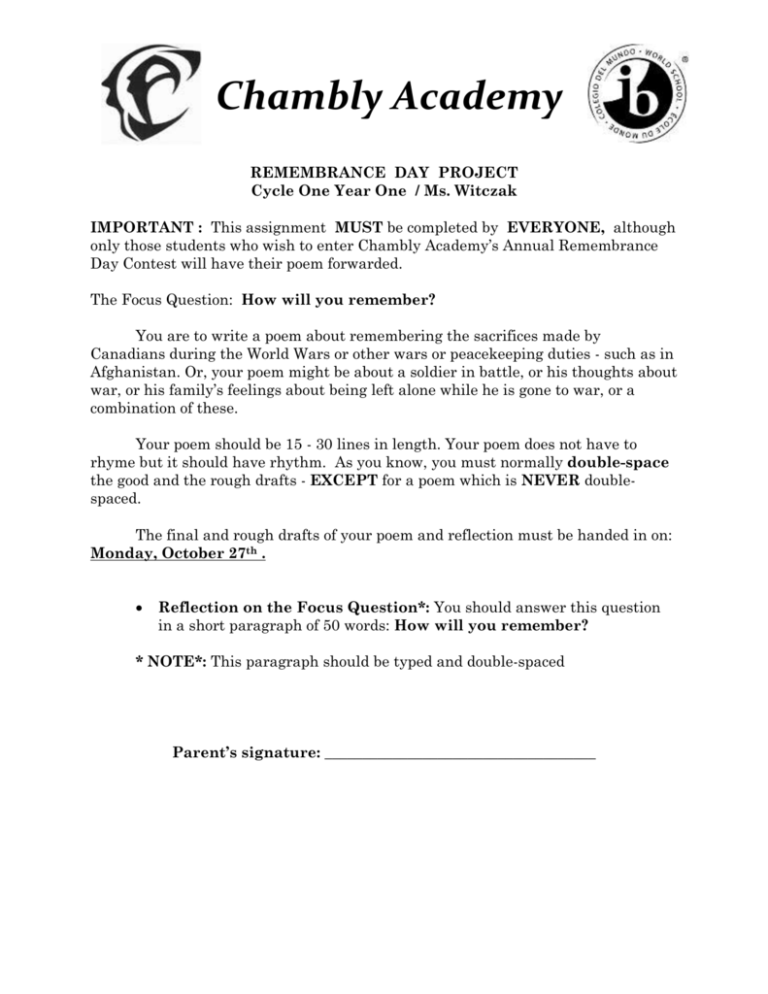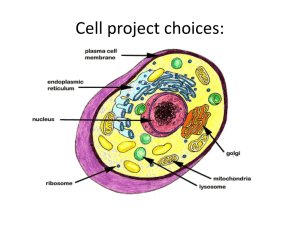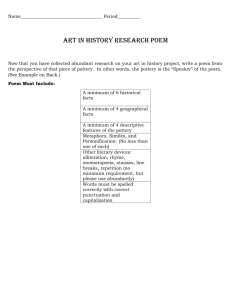File - English with Miss Witczak
advertisement

Chambly Academy REMEMBRANCE DAY PROJECT Cycle One Year One / Ms. Witczak IMPORTANT : This assignment MUST be completed by EVERYONE, although only those students who wish to enter Chambly Academy’s Annual Remembrance Day Contest will have their poem forwarded. The Focus Question: How will you remember? You are to write a poem about remembering the sacrifices made by Canadians during the World Wars or other wars or peacekeeping duties - such as in Afghanistan. Or, your poem might be about a soldier in battle, or his thoughts about war, or his family’s feelings about being left alone while he is gone to war, or a combination of these. Your poem should be 15 - 30 lines in length. Your poem does not have to rhyme but it should have rhythm. As you know, you must normally double-space the good and the rough drafts - EXCEPT for a poem which is NEVER doublespaced. The final and rough drafts of your poem and reflection must be handed in on: Monday, October 27th . Reflection on the Focus Question*: You should answer this question in a short paragraph of 50 words: How will you remember? * NOTE*: This paragraph should be typed and double-spaced Parent’s signature: ____________________________________ 2 EVALUATION: (See attached rubrics) A bonus of 5 marks will be given to those students who have their poems forwarded to the School’s Remembrance Day Contest. If you are interested in competing in the competition, you must be willing to read it aloud at the Remembrance Day Ceremony on November 11th. You will receive another 5 bonus marks if your poem is chosen as the Cycle One winner. Your mark will be based on the theme, description, grammar usage, and editing for the final copy. The rough copy will be evaluated mainly on the corrections and editing you made. Class readings of the poems will take place during the week of October 27November 4th. 3 Name: ______________________ I would like my poem to be forwarded to the School Competition: Yes No Remembrance Day Project Rubrics Theme Description 1-3 -Message is unclear. -No personal point of view expressed or suggested. -Weak details or examples are included. 4-6 Message is partially communicated with an attempt to show point of view. -Few details included. Some examples do not support message or are unclear. 1-3 Little or no descriptive words or phrases are used. 4-6 Some descriptive words and phrases are used to 'paint pictures' for reader. Word choice does not help to create an emotional response for reader. Conventions 1-3 Does not edit poem for spelling or punctuation. Frequent errors interfere with reader's ability to understand the message. Rough Copy Editing 1-3 Little to no changes made to the first and second drafts. Visual Assignment 1-9 -The visual piece shows little effort. Answering the Guiding Question and AOI 1-3 -The Guiding Question is not answered and AOI not mentioned. Presentation 1-6 Student mumbles and speaks quietly. 7-8 Message is clearly communicated and expresses personal point of view. -Includes several details which support the message and are linked together. 7-8 Several descriptive words and phrases are used to 'paint pictures' for reader. 9-10 Message is impactful & clearly expressed. Point of view is personal & insightful. -Details support and extend the message and work together to build momentum. 9-10 Many descriptive words and phrases are used to 'paint' detailed pictures for reader. Language choice begins to create emotional response for reader. 4-6 Edits & corrects some errors in spelling and punctuation. -Needs to use word wall, peer edit, and dictionary more effectively to identify and correct errors. Language choices create an emotional response. Language choices create strong emotional response. 7-8 Edits & corrects most errors in spelling and punctuation. -Uses word wall, peer edit, and dictionary to identify and correct most errors. 9-10 Edits & corrects all errors in spelling and punctuation. -Uses word wall, peer edit, and dictionary effectively to identify and correct all errors in conventions. 4-6 Uses a pencil, few changes are made to the first and second drafts. 7-8 Uses a highlighter and some changes are made first and second drafts. 10-18 -The student finishes the visual piece and shows some effort. 4-6 There is an attempt to answer the Guiding Question and to discuss the AOI. 19-24 -The visual piece shows evidence of care, detail and effort. 7-8 The student demonstrates a good understanding of the Guiding Question and reflects of the AOI. 7-12 Student’s voice is low. 13-15 Student’s voice is clear. 9-10 Uses a highlighter/ thesaurus and many changes are made to the first and second drafts. 25-30 -The visual piece is outstanding and finished with a great deal of detail. 9-10 The student demonstrates perceptive understanding of the Guiding Question and connection with the AOI. 16-20 Student uses a clear voice and reads with fluency. Overall Mark: ___________________ 4 Criterion C: Producing Text Achievement Level 0 1-2 The student does not reach a standard described by any of the descriptors below. The student: i. Produces texts that demonstrate limited personal engagement with the creative process; demonstrates a limited degree of thought or imagination and minimal exploration of new perspectives and ideas. ii. Makes minimal stylistic choices in terms of linguistic, literary and visual devices, demonstrating limited awareness of impact on an audience. iii. Selects few relevant details and examples to support ideas. 3-4 The student: i. Produces texts that demonstrate adequate personal engagement with the creative process; demonstrates some degree of thought or imagination and some exploration of new perspectives and ideas. ii. Makes some stylistic choices in terms of linguistic, literary and visual devices, demonstrating adequate awareness of impact on an audience. iii. Selects some relevant details and examples to support ideas. 5-6 The student: i. Produces texts that demonstrate considerable personal engagement with the creative process; demonstrates considerable thought or imagination and substantial exploration of new perspectives and ideas. ii. Makes thoughtful stylistic choices in terms of linguistic, literary and visual devices, demonstrating good awareness of impact on an audience. iii. Selects sufficient relevant details and examples to support ideas. 7-8 The student: i. Produces texts that demonstrate a high degree of personal engagement with the creative process; demonstrates a high degree of thought or imagination and perceptive exploration of new perspectives and ideas. ii. Makes perceptive stylistic choices in terms of linguistic, literary and visual devices, demonstrating good awareness of impact on an audience. iii. Selects extensive relevant details and examples to support ideas. 5 Criterion D: Using Language Achievement Level 0 1-2 3-4 5-6 7-8 The student does not reach a standard described by any of the descriptors below. The student: i. Uses a limited range of appropriate vocabulary and forms of expression. ii. Writes and speaks in an inappropriate register and style that do not serve the context and intention iii. Uses grammar, syntax and punctuation with limited accuracy; errors often hinder communication. iv. Spells/writes and pronounces with limited accuracy; errors often hinder communication. v. Makes limited and/or inappropriate use of non-verbal communication techniques. The student: i. Uses an adequate range of appropriate vocabulary, sentence structures and forms of expression. ii. Sometimes writes and speaks in a register and style that serve the context and intention. iii. Uses grammar, syntax and punctuation with some degree of accuracy; errors sometimes hinder communication. iv. Spells/writes and pronounces with some degree of accuracy; errors sometimes hinder communication. v. Makes some use of appropriate non-verbal communication techniques. The student: i. Uses a varied range of appropriate vocabulary, sentence structures and forms of expression competently. ii. Writes and speaks competently in a register and style that serve the context and intention. iii. Uses grammar, syntax and punctuation with a considerable degree of accuracy; errors do not hinder effective communication. iv. Spells/writes and pronounces with a considerable degree of accuracy; errors do not hinder effective communication. v. Makes sufficient use of appropriate non-verbal communication techniques. The student: i. Effectively uses a range of appropriate vocabulary sentence structures and forms of expression. ii. Writes and speaks in a consistently appropriate register and style that serve the context and intention. iii. Uses grammar, syntax and punctuation with a high degree of accuracy; errors are minor and communication is effective. iv. Spells/writes and pronounces with a high degree of accuracy; errors are minor and communication is effective. v. Makes effective use of appropriate non-verbal communication techniques.








